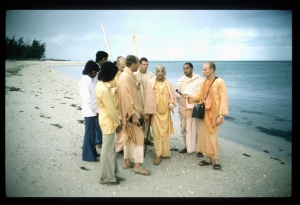CC Madhya 6.174 (1975): Difference between revisions
(Vanibot #0027: CCMirror - Mirror CC's 1996 edition to form a basis for 1975) |
(Vanibot #0020: VersionCompareLinker - added a link to the Version Compare feature) |
||
| Line 2: | Line 2: | ||
<div style="float:left">'''[[Sri Caitanya-caritamrta (1975)|Śrī Caitanya-caritāmṛta (1975)]] - [[CC Madhya (1975)|Madhya-līlā]] - [[CC Madhya 6 (1975)|Chapter 6: The Liberation of Sārvabhauma Bhaṭṭācārya]]'''</div> | <div style="float:left">'''[[Sri Caitanya-caritamrta (1975)|Śrī Caitanya-caritāmṛta (1975)]] - [[CC Madhya (1975)|Madhya-līlā]] - [[CC Madhya 6 (1975)|Chapter 6: The Liberation of Sārvabhauma Bhaṭṭācārya]]'''</div> | ||
<div style="float:right">[[File:Go-previous.png|link=CC Madhya 6.173 (1975)|Madhya-līlā 6.173]] '''[[CC Madhya 6.173 (1975)|Madhya-līlā 6.173]] - [[CC Madhya 6.175 (1975)|Madhya-līlā 6.175]]''' [[File:Go-next.png|link=CC Madhya 6.175 (1975)|Madhya-līlā 6.175]]</div> | <div style="float:right">[[File:Go-previous.png|link=CC Madhya 6.173 (1975)|Madhya-līlā 6.173]] '''[[CC Madhya 6.173 (1975)|Madhya-līlā 6.173]] - [[CC Madhya 6.175 (1975)|Madhya-līlā 6.175]]''' [[File:Go-next.png|link=CC Madhya 6.175 (1975)|Madhya-līlā 6.175]]</div> | ||
{{CompareVersions|CC|Madhya 6.174|CC 1975|CC 1996}} | |||
{{RandomImage}} | {{RandomImage}} | ||
==== TEXT 174 ==== | ==== TEXT 174 ==== | ||
<div class="verse"> | <div class="verse"> | ||
: | :'praṇava' ye mahā-vākya--īśvarera mūrti | ||
:praṇava haite sarva-veda, jagat-utpatti | :praṇava haite sarva-veda, jagat-utpatti | ||
</div> | </div> | ||
| Line 25: | Line 24: | ||
<div class="translation"> | <div class="translation"> | ||
"The transcendental vibration oṁkāra is the sound form of the Supreme Personality of Godhead. All Vedic knowledge and this cosmic manifestation are produced from this sound representation of the Supreme Lord. | |||
</div> | </div> | ||
| Line 32: | Line 31: | ||
<div class="purport"> | <div class="purport"> | ||
Oṁkāra is the representation of the Supreme Personality of Godhead in sound. This form of His holy name is accepted as the transcendental vibration (mahā-vākya) by virtue of which the temporary material manifestation has come into being. If one takes shelter of the sound representation of the Supreme Personality of Godhead (oṁkāra), he can realize his constitutional identity and engage in devotional service even though in | Oṁkāra is the representation of the Supreme Personality of Godhead in sound. This form of His holy name is accepted as the transcendental vibration (mahā-vākya), by virtue of which the temporary material manifestation has come into being. If one takes shelter of the sound representation of the Supreme Personality of Godhead (oṁkāra), he can realize his constitutional identity and engage in devotional service even though in conditional life. | ||
</div> | </div> | ||
Latest revision as of 18:39, 27 January 2020

A.C. Bhaktivedanta Swami Prabhupada
TEXT 174
- 'praṇava' ye mahā-vākya--īśvarera mūrti
- praṇava haite sarva-veda, jagat-utpatti
SYNONYMS
praṇava—oṁkāra; ye—that which; mahā-vākya—transcendental vibration; īśvarera—of the Supreme Personality of Godhead; mūrti—the form; praṇava—oṁkāra; haite—from; sarva-veda—all Vedic literature; jagat—of the material world; utpatti—production.
TRANSLATION
"The transcendental vibration oṁkāra is the sound form of the Supreme Personality of Godhead. All Vedic knowledge and this cosmic manifestation are produced from this sound representation of the Supreme Lord.
PURPORT
Oṁkāra is the representation of the Supreme Personality of Godhead in sound. This form of His holy name is accepted as the transcendental vibration (mahā-vākya), by virtue of which the temporary material manifestation has come into being. If one takes shelter of the sound representation of the Supreme Personality of Godhead (oṁkāra), he can realize his constitutional identity and engage in devotional service even though in conditional life.